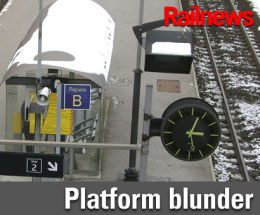Posted 21st May 2014 | 6 Comments
Separation of track and train blamed for costly error

FRENCH operator SNCF is said to be facing a bill of at least 50 million Euros after discovering that hundreds of platforms will need to be adjusted or partially rebuilt because new trains for its regional network are too wide.
The revelation of the blunder has been followed by criticism of the Europe-wide separation of track and train, which the French transport minister described as 'absurd'.
The French rail infrastructure is the responsibility of a separate company, RFF, which is the equivalent of Network Rail in Britain. RFF is accused of giving the wrong platform dimensions to SNCF when new Régiolis Regional Express Trains from Alstom were being designed, and an RFF spokesman admitted that it had 'discovered the problem a bit late'.
The trains, known as Trains Express Régionaux or TERs, were first unveiled in Bordeaux in the summer of 2013 and then in Paris last month, but news of the clash of dimensions has only emerged in the past 24 hours. Alstom said in July last year that 182 of the 'next generation' TER trainsets had been ordered by 12 French regions.
However when asked for data about platform clearances it appears that RFF measured only relatively new platforms built since the 1980s, overlooking the fact that most stations are older and their platform profiles are tighter.
Work on adjusting the platforms has begun, but it is reported that around 1,000 will need their profiles corrected and that the final bill could reach 100 million Euros. An SNCF spokesman attempted to minimise the problem, agreeing that there were some issues but that they were "not as bad as some sources are claiming".
The error has also sparked new criticism of the wisdom of separating infrastructure operators such as RFF from train companies like SNCF, which has been the policy of the European Commission for more than 20 years. French transport minister Frederic Cuvillier said: "When you separate the rail operator from the user, it doesn't work."
Reader Comments:
Views expressed in submitted comments are that of the author, and not necessarily shared by Railnews.

Graham Harwood, Manchester
Given that, until fairly recently, SNCF was also the infrastructure provider, blaming it all on RFF is a bit thin. They must have had the structure gauges available as part of other rolling stock renewals. What pertained then, pertains now. Own goal SNCF!
David Cook, Broadstone, Dorset
Having lost count of the number of times that I've read in the press about how good the railways in France are (always from people who like to slate our "outdated" railways over here, probably the same people who are also anti HS2), I found this story almost unbelievable. I am amazed that the French railways have no standardization of loading gauges and such a basic error was made. This shows that in this age of computers doing complex calculations, people should not just blindly accept what the computer says. Particularly when there is some £100 million Euros at stake!
Roshan Payapulli, Leeds
I think train operators in the UK should be given more control over the infrastructure they use. They could invest in the infrastructure more and they should maintain the infrastructure they use themselves. Network Rail would still charge them for track access and using the infrastructure (so it would still be government property) but the money the operators pay to NR will be a lot less as they would not have to pay for so many other costs. If an operator wished to invest (e.g. electrifying their routes) then their project would be partly-funded by NR and the rest of the funds would be their own, and they would carry out the project themsleves. Surely this would be a more efficient and more cost effective way to manage infrastructure? I think this would increase investment and electrification as First Hull Trains have already expressed their desire to complete the electrification of their route using all their own funding.
Lutz, London
They can make the claim, but that does not make it true,
Further, if you look at the details this problem arose within the rail authority and would still have happened if the two bodies were still combined.
Tony Pearce, Reading
Don't the French have 'Loading Guages'. Surely that is at the heart of all Railway Design - tunnels, bridges and platforms. Didn't they have a 'test-train' ? If the trains are too wide its the fault of both the customer and the manufacturer. As a retired Senior Analyst, I spent most of my time checking that I had correctly identified what the customer wanted because whatever is being made, its so expensive to put it right after the design stage. You just end up with a disatisfied customer and supplier who sue each other in the Courts for ages otherwise. It has, in my opinion, absolutely nothing to do with seperating track and train.
James, London
Don't they check the route gauge when considering new trains in France?